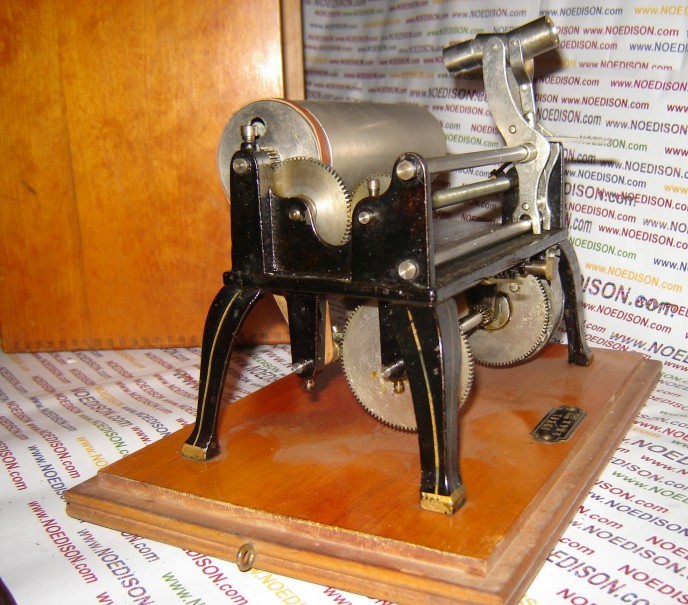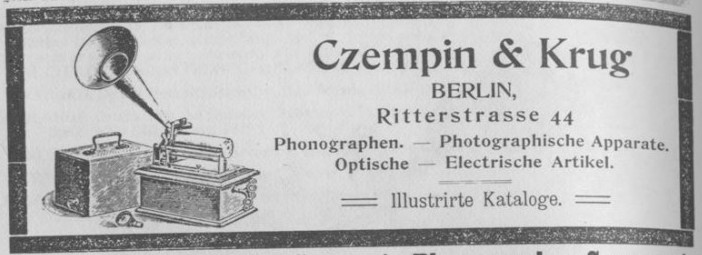No Edison
Antique phonographs from various manufacturers
Czempin & Krug
Either at the end of 1898 or beginning of 1899 Edmund Czempin hired a young engineer called Carl Lindström away from his the company where he was employed, to be the manager of the manufacturing side of the phonograph factory Czempin & Krug, based at Dresdenerstraße 24. Czempin had been looking for a skilled technical manager for his factory, in order to ramp up production of „cheap“ phonographs, especially for export to England.
(If you are interested in the history of the European phonograph and gramophone industry, you will learn that Carl Lindström was to become on of the major players in this industry)
It is believed that up to the time Lindström joined, Czempin & Krug only produced Puck style machines. These were at a better quality and cheaper than those of competitors, and thus Czempin & Krug did quite well in this segment.
Lindström wanted to do more than just imitate, and from January 1899, he began to regularly file patents for improvements to phonograph models, such as a sound box with paper cone, a silent motor for phonographs, etc. Czempin & Krug sold their products exclusively to wholesalers. Czempin & Krug also produced photographic, optical and electrical items as well as violins and a range of childrens drums.
Under Lindström’s management the range of talking machines of Czempin & Krug during 1899 consisted of two Models:
- the “family phonograph” of typical puck lyre form.
- "Ideal Phonograph" which was a recording and reproducing phonograph This was in fact the first "real" Lindström designed phonograph, and in the 1899 version had an open metal motor housing.
During the next year, the "family phonograph" experienced little change. However in mid-1900 an improved "Ideal", was released, the "Model 1900 / 1" which had the motor enclosed in a wooden cabinet. This well engineered phonograph was the inspiration (ie copied) by many other small Berlin based phonograph companies.
In February 1901 Czempin & Krug entered their “Ideal” in the large European "Phonographic competition" that was held in Berlin. (not sure how they did?)
Due to the restricted space in Dresdenerstraße 24 where it was not possible to expand production due to lack of space, the factory was moved to Brückenstraße 13a which was strategically located directly next to the newly renovated and expanded transportation hub of the Jannowitzbrücke.
Matters took a downturn however toward the end of 1901, because Czempin had overextended his financial means and was in economic and financial difficulties. He placed advertisements in various newspapers trying to sell off his old stocks of phonographs in order to become more liquid, even trying to sell directly to individuals.
During 1902 matters deteriorated into Bankruptcy, and on 2 May 1903, Czempin committed suicide, thus definitively ending the Czempin & Krug company.
Lindström had been forced, even in the time leading up to the bankruptcy of Czempin & Krug, to market the new improved "Ideal" phonograph, under his own devices, even though engineering and not marketing was his forte.
He had a stroke of luck in that, in 1903, the new “moulded” cylinder records were introduced (i.e. mass production) which reduced the price of cylinders, thus making a phonograph a cheaper prospect for the average man in the street. Lindström was also setting up his own company and for Lindström, business went from strength to strength.
(Translation - based on "Die Vorgeschichte der Carl Lindström, A.G." by Stephan Puille.)nd Czempin
crucial for the further development Lindström was meeting with the "founder of the German export industry, Phonograph," 8 the merchant Edmund Czempin,
Sole owner of Czempin & Krug, with a sales office and model camp in the Knights Road 44a, middle of the old export center in Berlin-Kreuzberg. Czempin was looking for a technical director for his factory for the mass production of cheap phonograph, mainly for export to England.
Carl Lindstrom left the end of 1898 or beginning of 1899 his old company in the Grimm Road and took over the management of the commercial court registered "phonograph factory Czempin & Krug," Dresdenerstraße 24, not far from the Kottbusser Tor.9 It is likely that the factory initially only the " Puck "replicas, which succeeded it seems to compete with quality at low production costs compared to competitors, because although the Lindström" Puck "neither designed nor introduced in the market, his name is inextricably linked with this unit verknüpft.10
Lindström was more than just imitators, since January 1899, he reported regularly patents and utility models for talking machines, etc. for a sound box with paper cone and a "silent drive for phonograph." 11 The marketing exclusively to wholesalers took over the company Czempin & Krug, who also had photographic, optical and electrical items as well as violins and children drums in the range.
The offer in talking machines of Czempin & Krug consisted of two types: ". Ideal" to the "family phonograph" with lyrenförmiger substrate and the recording and reproducing phonograph This first "real" Lindström phonograph was in the version of 1899 is still an open metal motor housing. During the "family phonograph" well-experienced little change, was released mid-1900 a better "ideal", the "Model 1900 / 1" with wooden Motorgehäuse.12 The company Czempin & pitcher with the beautifully engineered device, copied by many of Berlin's workshops, at large "Phonographic competition" in early February 1901 in Berlin teil.13
4. Moving to the bridge 13a
Because the rooms in the Dresdenerstraße 24 is no longer possible for the continuous expansion of production was sufficient Lindstrom founded in 1900 its own "phonograph factory and
mechanical workshop "in the bridge 13a, Berlin-Mitte.14 Located directly next to the just renovated and expanded transportation hub Jannowitzbrücke left Lindström for the first time the district Berlin-Kreuzberg.
End of 1901 came Czempin Edmund, who had taken over economic, financial difficulties. He went through an advertisement, the old stocks of his phonograph-bearing money, and he remained devices even in retail to sell versuchte.15 The situation escalated on 2 May 1903, as Czempin voluntarily retired from life.
Lindström had been forced before the bankruptcy of Czempin & Krug, the new, original "ideal" phonograph, "the" model 1903 "with crank lift and revised Schalldosenarm on your own to vermarkten.16 He was lucky, the business phonograph was booming after the introduction of the new cast iron rolls, in particular workers and line employees now bought large quantities of cheap roller player(
Czempin & Krug Family Phonograph
Link to ROMFIxx
Czempin & Krug Ideal Phonograph 1899
Link to ROMFI
The first Linström designed machine was a very unique in design. It was an open works machine with the frame including the 4 legs, being a single iron casting. It has a single spring.

It is quite a rare model with only about 6 known to have survived.
Czempin & Krug Ideal Phonograph 1900-1902
Link to ROMFI
xxxx

x